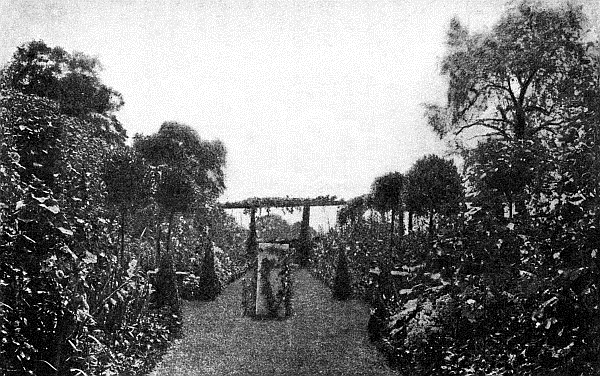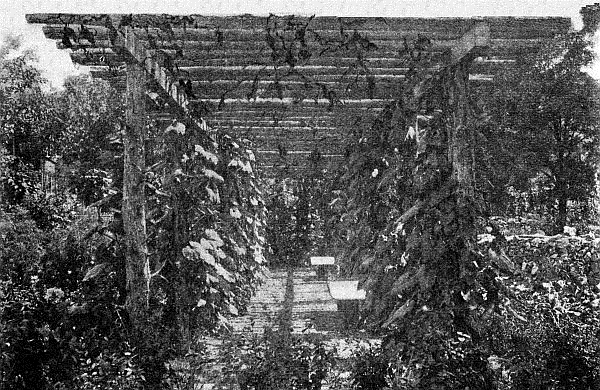 полная версия
полная версияA Woman's Hardy Garden
These all yield beautiful flowers, beside being hardy and of rapid growth.
All shrubs should be trimmed as soon as they have finished flowering, but only enough to prevent their becoming spindling, with the exception of Hydrangea grandiflora, which should be trimmed back, at least three-quarters of the new growth, every year.
It is important, also, to thin out the old wood of most shrubs after five or six years.
Shrubs can be grown from cuttings if one has patience to wait for the result. But as it takes from three to four years’ time and considerable care to grow a shrub that would cost but twenty cents, for which price many varieties of shrubs can be bought, few people care to raise them.
On a large place it might be worth while to raise shrubs from cuttings. And where there is plenty of space, a small nursery of them might be kept.
At the end of June take clippings about a foot long, make a shallow trench in good ground and plant them a couple of inches deep. They should be well rooted, in about six weeks. If the weather be dry, after planting them, they must be watered daily. The following spring they should be reset, a foot apart, where they can grow until transplanted to their final resting place. I know a beautiful hedge of Cydonia Japonica, or Japanese Quince, that has been grown from cuttings. Privet can easily be grown from cuttings, and I have raised Box from clippings. Fortunately, the season was a wet one, for if allowed to become dry before being well rooted, they would probably have died.
List of Most Satisfactory ShrubsAltheas, pink or white; blooms in August. Jeanne d’Arc, pure double white, the best. Grows six to eight feet in five years; must be trimmed in October.
Berberis Thunbergii, or Barberry, of slow growth; about three feet high; desirable for its beautiful foliage and scarlet fruit in winter.
Calycanthus floridus, or Sweet-scented Shrub. It yields its brown blossoms the end of May; slow-growing; requires but little trimming; height, five to six feet.
Cydonia Japonica, Japanese Quince, has brilliant red blossoms in early May; grows six to seven feet high.
Deutzia crenata, variety of pale pink, and Candidissima, white; of rapid growth, and very high; six to eight feet in five years.
Forsythia blooms in April with masses of yellow flowers; moderate, quick growth; seldom over six feet high.
Hydrangea paniculata grandiflora, the finest of all hardy shrubs. The flowers are great panicles of white. They bloom about the first of August and remain beautiful for six weeks, slowly changing to a soft, dull pink. This shrub is most effective when grown in masses of a dozen or more, although single specimens are very fine. They must be vigorously cut back late every fall, leaving only about six inches of new growth.
Lilac, common purple and common white; also Marie Legray, a fine white Lilac, and Madame Lemoine, a new double variety bearing very large trusses of flowers. All of these varieties of Lilac grow high and rapidly – frequently eight feet in six years. They require little or no pruning. It is sufficient to cut the blossoms either before or after they go to seed.
Lonicera rosea and Lonicera albida, upright Honeysuckles, in shrub form, vigorous, quick-growing, requiring but slight pruning in late autumn. They flower in May, and in midsummer are covered with beautiful berries.

Vase of Hydrangea paniculata grandiflora
September tenth
Magnolia conspicua, with large white blossoms, blooms the middle of April; Soulangeana has large pink flowers and blossoms the end of April. Magnolias should be pruned when set out, and should be moved only in spring.
Philadelphus syringa, or Mock Orange; grandiflorus is the finest. The flowers are pure white, very fragrant and bloom about the middle of June. The shrub grows high, is perfectly hardy and in every way satisfactory. It should be trimmed as soon as it has finished blossoming. Cut back about three-quarters of the new growth; it will then send out side shoots and become continually thicker.
Privet. The common Privet is of very rapid growth and excellent for a screen. It should be trimmed the end of June, but only enough to prevent its becoming scraggly. The California Privet is not so hardy.
Rhus Cotinus, popularly known as Smoke Tree or Purple Fringe, grows as high as a small tree and requires almost no pruning. In midsummer it is covered with fine, mist-like, purple flowers.
Spiræa Van Houttei. This is one of the most satisfactory shrubs; is rather dwarf in habit, growing about five feet high. The end of May it is covered with clusters of white flowers on long, pendulous branches. Trim as soon as it has finished blooming, cutting off about half of the new growth.
Spiræa Anthony Waterer, another Spirea, very dwarf, only about a foot in height, and covered with bright crimson flowers from June to October.
Viburnum plicatum, Japan Snowball, one of the finest shrubs. It grows about six feet high, and is completely covered with its balls of snow in early June. It requires comparatively little trimming.
Weigela.– The two most satisfactory varieties of this shrub are Candida, whose blossoms are white, and Rosea, with pink flowers. They bloom most freely about the tenth of June, when each shrub becomes a mass of flowers. Care must be taken to cut out the old wood from time to time, and to trim after the shrub has finished blooming.
A Few Evergreen ShrubsOf evergreen shrubs, Kalmia latifolia, or Mountain Laurel, is most satisfactory, growing three to four feet high. It is covered in early June with large clusters of pale pink and white flowers.
Rhododendron maximum, the large-leaved hardy American variety. Under cultivation this shrub seldom grows more than six feet high; in the woods it is found much larger.
Japanese Holly, a dense-growing shrub about four feet high, with deep glossy green foliage.
Tree Box, generally trimmed in standard or pyramidal form and very slow-growing.
Perennial Vines and CreepersAmpelopsis quinquefolia, Virginia Creeper.
Ampelopsis Veitchi, Boston Ivy.
Aristolochia Sipho, Dutchman’s Pipe.
Bignonia radicans, Trumpet Creeper.
Clematis paniculata, clusters of fine white flowers.
Clematis Henryi, large white flowers.
Clematis Jackmani, large purple flowers.
English Ivy.
Honeysuckle, Hall’s Japan, Golden Japan.
Hops.
Vitis Coignetiæ, Japanese ornamental grapevine; rapid grower.
Wistaria, both purple and white.
A Few of the Best Annual VinesCobæa scandens, purple and white.
Moonflower, white.
Japanese Morning-glory, all colors.
Passion Flower, blue and white; must be started very early, and if well protected will sometimes survive the winter.
Japanese Gourd. This must be descended from Jonah’s Gourd of biblical fame, as it often grows from forty to fifty feet in a summer. It has yellow flowers and gourds, and is very decorative.
WATER, WALKS, LAWNS, BOX-EDGINGS, SUN-DIAL AND PERGOLA
CHAPTER XIV
WATER, WALKS, LAWNS, BOX-EDGING, SUN-DIAL AND PERGOLAIt is not advisable to arrange for a garden of any size without considering the question of water. Within the limits of a town supply there is only the comparatively simple matter of laying the pipes. But when the place is dependent upon its own water system, the amount to be counted upon and the situation of the garden with reference to the source of supply must be seriously considered. If possible the garden hydrants should not be more than fifty feet apart. This greatly facilitates watering. When further apart, plants are in danger of being injured by the unwieldy hose. A nozzle that will regulate the flow of water from a fine spray to a strong stream will be found convenient.
Opinions differ upon the best way to lay water-pipes through a place, some preferring to put them but a foot under ground, and turn off the water in winter; others lay them in trenches three and a half to four feet deep, so that they are beyond all danger from frost. This latter plan was followed in my garden and I recommend it as being most satisfactory.
The watering of a garden requires nearly as much judgment as the seasoning of a soup. Keep the soil well stirred and loose on the surface, going through the garden, where possible, with a rake; and if there is no room for a rake, stir gently with a trowel every five days or once a week. In this way moisture will be retained in the soil, since the loose earth acts as a mulch.

Vase of double hardy Sunflowers (Helianthus multiflorus plenus)
September fifteenth
When watering, be generous. Soak the plants to the roots; wet all the earth around them, and do it late in the afternoon, when the sun is low. How often have I been obliged to chide the men for watering too early in the afternoon, and not doing it thoroughly, for, upon stirring the ground, I would find that the water had penetrated but a couple of inches. During long periods of dry weather, the garden, without water, will simply wither and burn.
Rhododendrons, Ferns and Lilies suffer in dry time, even though well mulched, and must be kept moist.
Japanese Iris blooms but indifferently unless quite wet.
When dry weather continues for a long period I divide the garden into three parts; one part is thoroughly watered every evening, and the following day the soil is stirred. In this way the plants suffer comparatively little. For years we had no water supply through the gardens, and really, in dry weather, life had no pleasure for me because of my unhappiness at the sight of the withered garden. I would drag watering-cans about, and beg and bribe all the family to do likewise. Every afternoon, about five o’clock, one of the men would fill eight ten-gallon milk-cans with water, put them in a wagon, and drive about the place watering the flower beds and borders. Frequently he would fill these cans three times in one afternoon. This, as may be imagined, was slow and unsatisfactory work, and, except in the case of a small garden, is too great a task.
Often in a dry time, after dinner, I bethink me of the Rhododendrons or Ferns or Iris, or some other plants to which drought means death, and I feel sure “that boy has not watered them enough.” Then, in ten minutes the garden skirt, shoes and gloves are on, and those thirsty plants get a drenching to their very roots such as they would never receive from any perfunctory “boy” or gardener. I go to bed warm and weary, yet sleep is sweet from satisfaction at the thought of the garden’s happiness.
WALKSUnquestionably, walks near the house should be graveled; they naturally have too hard usage to keep turf in good condition. Graveled walks should be dug out a foot or more in depth, filled in with broken stone, this covered well with coarse gravel, and finished with a coating of a couple of inches of whatever fine gravel is chosen. A walk thus made will be dry and well drained and weeds have little chance to grow.
The most beautiful walks of all are those of grass. Strange to say, they are seldom seen in this country. Through any garden, some little distance from the house, where they will be walked on only by those going to the garden, the turf-walks, with ordinary care, will last well, require only the usual cutting with the lawn-mower, and, especially if edged with Box, should be the very pride and joy of the possessor’s heart.
The ground for such walks should be spaded deeply with plenty of manure, raked carefully and made very smooth. Prepare in September, and by the fifteenth or twentieth sow, very thickly, a mixture of one-third each to the bushel of Kentucky Blue Grass, Long Island Bent Grass and Red Top. Roll thoroughly, and if the weather be dry have the newly sown paths sprinkled daily and kept moist. The tender grass should appear in two weeks, and will continue to grow during October.

Vase of Monkshood
September thirtieth
About Thanksgiving time of the first year, cover with a layer of straw, and uncover about the twenty-fifth of March. At this time it is well to sow thinly some more grass seed of the same kinds, and again roll, the reason for the additional spring sowing being to replace any of the grass that may have been winter-killed. About the twentieth of April spread cotton-seed meal, the best of all fertilizers for grass, all over the paths. For years we have had the lawns covered with stable manure in February and raked off the first of April, and for years I have waged war with the weeds and wild grasses. But sow cotton-seed meal early in April, and if possible give the paths a little wood-ashes in June; the result will be a hundred per cent better than from the use of manure. Cotton-seed meal should not be sown too thickly, and wood-ashes must be spread thinly, so as not to burn the grass.
The men tell me that a sharp-pointed mason’s trowel is more satisfactory than any other tool for removing weeds from the lawns and grass paths. If this is carefully attended to the end of May, and again the latter part of June, and only artificial fertilizer used, there will be but little trouble with weeds in the grass.
BOX-EDGINGBox-edging should be set out in the spring, that it may be thoroughly rooted before winter.
Great care must be taken in setting out the Box, that the row be absolutely straight and even. The garden cord is carefully stretched; a shallow, narrow trench is dug with the spade, and then the little plants are placed about three inches apart, each plant against the string. The trench is half filled in with earth, then a layer of manure, and finally more earth packed down. Box planted in this way should grow and thrive, especially if given, along in May, a little bone-meal.

Sun-dial in center of formal garden
August second
I write feelingly of Box-edging to-day. Last week, Holy Week, I spent in the country, and most of my time was passed on my knees. For, when not at church or driving the intervening five miles, I was setting out plants in the garden, and that, like one’s prayers, requires kneeling. Four men were working, setting out plants and trees, but the earth was so sweet and warm and brown that it was impossible to keep away from it. With trowel in hand and joy in my heart, I set out hundreds of little Box plants, transplanted Columbines, Foxgloves and Canterbury Bells. Big robins were hopping tamely about, calling to one another; blackbirds and meadow-larks were singing their refrains; the brave plants were pushing their way through the earth to new life, and I thought how good it was to be alive, to have a garden to dig in, and, above all, to be well and able to dig.
With work in the garden care and worry vanish. The cook (as some cooks of mine have done) may announce that “’tis a woild waste of a place. I be lavin’ the mornin’.” The hamper of meat does not arrive on the one train from town, or somebody smashes something very dear to your heart, – just go to the garden, tie up some Roses or vines, or poke about with a trowel, and though murder may have been in your thoughts, in half an hour serenity will return. And what does it all matter, anyway? Another maid can cook for a few days, and there are always bacon and eggs.
Philosophy is inevitably learned in a garden. Speaking of eggs, I think of hens. Living on a farm, of course there have always been hens and chickens. These creatures were provided with houses and yards and fences, and given every inducement to remain where they belonged; yet with diabolical ingenuity they would escape from their quarters, dig under the fence, fly over it, or some one would leave a door or a gate open, and then, with one accord, all the flock would make for the gardens and scratch and roll in the borders. This sort of thing happened repeatedly, until I felt there must be a league between the farmer’s wife and the hens. But the limit of endurance was reached when, one afternoon, coming out to look at a bed of several dozen Chrysanthemums set out in the morning, I found the poor plants all scratched out of the ground, broken and wilted. Then in wrath the fiat went forth, “No more hens on this farm, those on hand to be eaten at once.” For days a patient family had hen soup, hen croquettes, hen salad and hen fricassee, until the last culprit came to her end.
SUN-DIALThere is no more charming and interesting addition to a garden than a sun-dial. For hundreds of years sun-dials have been used as timekeepers, and though some of the very old ones were occasionally set into the façade of a building, they are generally found in the plaisaunce or garden, mounted upon quaint pedestals. Sun-dials are supposed, by their owners, to keep accurate time, but it must be remembered that there is always a difference between clock-time and sun-time. While, to-day, our lives are frequently portioned into minutes, and it would seem as if one might loiter and be lazy in a garden, if anywhere, still even among the flowers we find a “tempus fugit.” For a time after my sun-dial was set, it was amusing to notice how often, about half after eleven o’clock, and again at five, this late addition to the garden would claim the attention of the workmen.
My sun-dial stands in the center of a formal garden where four paths meet, forming a circle twenty feet across. The pedestal is a simple column of marble, four and one-half feet high, slightly tapering toward the top, with beveled corners. This is placed on a stone foundation three and one-half feet deep, laid in cement. The pedestal I found at the yard of a second-hand building-material man, on Avenue B, in New York city. After it had been set in place, I wanted it rubbed up and a chipped place smoothed. The only available man for this work, was the gravestone-cutter from the nearest town. When he was recognized at work in the garden by passing countrymen, they supposed, of course, that some one was buried there, and many have been the inquiries as to “whose be that mouny-ment.”
Crimson Rambler Roses twine about the pedestal. At the corners of the four paths are standard Box trees, which stand like sentinels, and between them there are Bay trees in terra-cotta vases of simple shape – copies of antique ones.
The dial made for the latitude bears this inscription, “Utere praesenti, memor ultimae” (Use the present hour, mindful of the last), which I found in an old book on sun-dials in the Avery Library, at Columbia University.
PERGOLAAcross the end of this garden is a rustic pergola seventy feet long, made of cedar posts cut from the woods on the farm, ten posts on a side, each post being set four feet deep. A string-piece of heavy chestnut rests on the tops of each row of posts. Cedar poles ten inches apart extend across the top and project two feet over each side. The pergola is eight feet wide and ten feet high, is easy to build and very effective. Care must be taken to set the posts at least four feet. At each post are planted a two-year-old root of Wistaria and one of Virginia Creeper, and I live in the hope of some day seeing the vines cover the pergola. The ground slopes gently where this is built, and the first autumn after it was made, it looked, from a little distance, so much like a section of an elevated railroad as to be very depressing. But one must possess imagination to be a gardener, and have the ability to see the garden as it will look “next year.” So I refused to see the pergola except as clothed with vines, and in May, with the beautiful racemes of Purple Wistaria hanging from every rafter.
Patience and perseverance are traits necessary to the gardener. One must not be discouraged, but determined to succeed. If a set of plants die, or do not flourish this year, try them again next season, under different conditions, until the difficulties are overcome. I have known people who began gardening as a mere pastime when over forty years old, and who have told me what an absorbing interest it had become and how greatly it changed the whole aspect of life for them in the country. What a delightful tie, fondness for gardening makes between people! I know several men with beautiful places and lovely gardens in which they take the warmest personal interest. Whenever I meet one of them at dinner, if by chance I am not seated next to him, I am unhappy and cannot listen sympathetically, either to the enthusiasm of the man on one side whose heart is, perhaps, bound up in golf, or to the laments of my neighbor on the other, who may be suffering from rheumatism or gout, and unable to eat or drink what he wants.
INSECTICIDES – TOOL-ROOM
CHAPTER XV
INSECTICIDES – TOOL-ROOMThe enemies of growing things have certainly increased alarmingly of late years. I cannot recall that formerly any insect was to be found in either vegetable or flower garden, other than the potato bug, currant-worm, cabbage-worm, and the green worm and small black beetle on the Rose; but now there are so many horrid creatures lying in wait until a plant is in perfection, to cut the stalk, or eat the root, or eat the pith from the stalk so that it falls, or to devour the leaves and eat the blossoms, that insecticides and a spraying machine are as necessary to a garden as a spade. For a small garden a spraying machine holding from a couple of quarts to a gallon, can be bought for a trifling sum, that will answer the purpose very well For a larger garden, a good air-pump, costing from five dollars upwards, will be found an excellent investment.
One of the best insecticides is Bordeaux mixture, which can either be bought or made. I have twenty-five gallons made at a time and keep it always on hand. The following is the receipe:
Three pounds of blue vitriol in coarse crystals; three pounds of unslaked lime. Slake the lime in two and one-half gallons of water; pour two and one-half gallons of water over the blue vitriol in another receptacle, and let both stand over night. In the morning stir the blue vitriol until all is dissolved; then let two persons pour simultaneously the lime water and the blue vitriol into the same receptacle, and add twenty gallons of water; stir well before filling the spraying machine.

The Pergola (first summer)
August twenty-fifth
Bordeaux mixture is to be used for rust, mildew, and all kinds of blight, whenever the leaves of plants have a tendency to turn black. Hollyhocks seem to be universally attacked by rust. Spraying the plants at the end of April, and again in the middle of May, should entirely prevent this. I have found that Bordeaux mixture prevents the leaves of Monkshood from turning black and falling off, if the plants are well sprayed with it about the middle of June and the first of July.
Phloxes grown in rather shady places will, in damp weather, fall victims to mildew on the leaves. Spraying with Bordeaux mixture the end of June and middle of July should prevent this. Roses also have a tendency in warm, damp weather to mildew, which can be prevented by spraying the plants with Bordeaux mixture.
Kerosene emulsion may also be prepared, and is excellent for killing, both the small green aphids that often cover the leaves of Roses, and other hard, scaly insects. Following is the receipe:
Put one cake of laundry soap shaved fine into one gallon of water. When dissolved, add two gallons of kerosene oil. This makes the emulsion.
For spraying, use one quart of the emulsion in fourteen quarts of water. Be sure that this is very thoroughly mixed before filling the sprayer.

